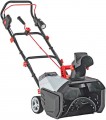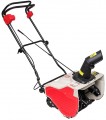Motor type
—
Petrol. An internal combustion engine that uses gasoline as fuel. Such engines are often more powerful than electric ones, and do not depend on being connected to the mains or the length of the power cord. On the other hand, gasoline snow blowers are usually heavier, have a higher noise level, and emit combustion products into the air. In addition, they are more expensive to operate and require the purchase of fuel and lubricants. You should pay attention to such machines if you plan to work on large areas and/or in the absence of electricity.
—
Diesel. Internal combustion engines running on diesel fuel. It is easier to achieve high torque in such engines than in gasoline engines; however, this requires sacrificing speed, but this is not critical for snow blowers. In addition, diesel fuel is cheaper than gasoline. On the other hand, the engines themselves are quite expensive and difficult to maintain, and at low temperatures they often have problems starting. Therefore, diesel engines are not very widespread; they are found only in a few models of heavy professional snow blowers.
—
Electric(mains). Snow blowers with electric motors are usually powered by a regular 230 V mains. Compared to gasoline ones, such devices are lighter, cheaper to operate, produce less noise and do not pollute the air; in addition, they are more compact and easier to store. On th
...e other hand, the power of electric snow blowers is usually significantly lower, and mobility is limited by the length of the power cord. Such models can be recommended primarily to those who plan to clean relatively small areas in the immediate vicinity of power sources - for example, the yard of a private house or the exit from a garage.
— Electric (battery). Snow blowers with an electric motor, powered by a built-in battery. Such models have very low power and limited operating time, while they are more expensive and weigh more than their mains-powered counterparts. On the other hand, a battery-powered snow blower works without being connected to the mains and does not depend on the length of the wire. So such a unit will be an ideal choice for cleaning a relatively small area near which there are no sockets.Working width
The width of the strip of snow that the snow blower can clear in one pass. The larger the capture width, the fewer passes will be required to process the site, which is especially important on large areas. On the other hand, for processing small spaces, clearing individual paths, etc. significant width is not required (moreover, a “narrow” snow blower will pass more easily in a hard-to-reach place). The larger the capture width, the more powerful the engine, usually, ceteris paribus.
The most compact modern snow blowers have a working width of
less than 50 cm, these are mainly electric models of low power, although gasoline units are also found. A width of
50 – 60 cm can be called relatively small,
60 – 70 cm — medium, and in the largest models this figure
exceeds 70 cm.
Snow height
The maximum thickness of the snow layer that the snow blower removes in one pass. If you plan to regularly remove snow as it falls in a small area (for example, in the courtyard of your own private house), a grip height of up to 20 cm will be enough. If the opportunity to remove snow is rare (for example, in a country house where you visit only on weekends), you should pay attention to more powerful models with a height of about 50 cm.
Min. throw distance
The shortest distance that the snow blower can throw the collected snow.
The minimum range is indicated only for models with adjustable throw distance (see above). The meaning of this parameter is that in fact, long-range snow casting is not always desirable. For example, when clearing a path in the yard of a private house, snow often has to be poured literally next to the path, a little further — and it will fly onto the windows and walls of the house.
Note that the ejection range is a rather conditional value, because. snow (especially loose, freshly fallen snow) tends to dissipate in flight.
Max. throw distance
The maximum distance to which the snow blower can throw the collected snow (for models without throwing distance adjustment, the operating range itself). This value is rather arbitrary, since snow can be strongly dispersed in flight. Nevertheless, it characterizes the capabilities of the unit well and allows you to compare it with other models.
Long range is important mainly when working on large areas — it allows you to throw snow across the cultivated area so that it does not have to be collected a second time. As for specific figures, the value
up to 10 m is considered relatively small,
11 – 15 m — average, and in the most "long-range" models this figure can be
16 m or more.
Auger / brush rotation speed
The speed of rotation of the working tool of the snow blower.
Other things being equal, a higher speed is good for performance, a lower speed gives more torque and improves efficiency in hard snow and crust. However, in fact, this parameter is more of a reference than practically significant: manufacturers select the speed in such a way as to ensure sufficient efficiency and productivity. In addition, many models are produced with several gears, where the rotation speed can be adjusted.
Design
—
Self-propelled design. In self-propelled snow blowers, the built-in motor drives not only the auger, but also the wheels / tracks, ensuring the movement of the device. In this way, you do not have to push the snow blower by hand, which makes work much easier — especially with heavy, powerful models. Most self-propelled models have a transmission that allows you to adjust the speed of movement, as well as the ability to move backward (see "Number of gears").
—
Overload protection. A safety system that protects the unit from breakdowns in the event of critical loads. The main reason for the occurrence of such loads is the jamming of the screw — for example, due to the ingress of a foreign object. Therefore, most often, special bolts are used for protection, connecting the auger to the motor gearbox: with a sharp increase in load, the bolts are cut off and the auger is disconnected from the gearbox. Another option is overheating protection that reacts to engine temperature; it is found predominantly in electrical assemblies and can be used alone or in combination with shear bolts.
—
Headlights. The presence of a headlight (headlights) in the design of the snow blower allows you to use it for work at night, when there are no other light sources or they are not enough. In addition, in some models, the headlights turn on automatically every time the engine is starte
...d — they play the role of a warning signal that the unit is running.
— Heated handles. Heating system for handles, which the operator holds during work. This feature is especially useful as snow blowers are used in cold weather, and hands can get cold during prolonged use. On the other hand, with small volumes of cleaning, you can completely do with gloves, so heated handles are found mainly in powerful models with internal combustion engines, designed for large volumes of work.Motor power
Snowblower motor power in watts. This designation is used for all electric models; for units with an internal combustion engine (see "Motor type"), the designation in horsepower may also be given (see above).
The higher the motor power, the higher the snowblower's flow rate, the better it copes with high dense snowdrifts and icy crust. However, more powerful engines consume more fuel, weigh more and cost more, and their use is not always justified. Detailed recommendations on choosing the optimal power for a specific situation can be found in special sources.
Battery voltage
Nominal voltage of the battery used in the unit with the corresponding engine type (see above). Theoretically, a higher voltage allows you to achieve more power, but in fact there is no direct relationship between these points. In addition, manufacturers choose batteries to deliver the intended power, rotational speed, and other performance. Therefore, in the selection and normal use of the unit, this parameter has a secondary, reference value; it may be needed mainly for some specific tasks, for example, searching for a spare battery or a “non-native” charger, or comparing different batteries by capacity (see below).

